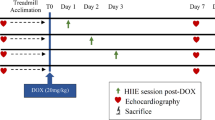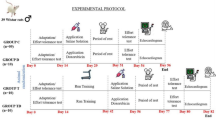Abstract
We tested the hypothesis that aerobic exercise training (AET) would modulate doxorubicin-induced cardiotoxicity in rats of various ages. Wistar male rats (n = 72) were assigned to three groups (young, adult, and elderly) with three subgroups for each age: doxorubicin (DG, n = 8), AET + doxorubicin (AETDG, n = 8), AET + Saline (AETSG, n = 8). Following the AET intervention, rats were anesthetized and killed to collect heart tissues in order to determine heat shock protein 70 (HSP70), superoxide dismutase (SOD), malondialdehyde (MDA), interleukin-10 (IL10), and c-reactive protein (CRP). Greater levels of SOD and lower levels of MDA were found in young as compared to elderly rats (P < 0.05). CRP was significantly lower in young as compared to adult and elderly rats, respectively (P < 0.05). IL10 also was significantly lower in young as compared to elderly rats (P < 0.05). Furthermore, lower HSP70 and SOD levels were found in DG as compared to AETDG and AETSG (P < 0.05). Conversely, MDA and CRP were significantly higher in DG as compared to other groups (P < 0.05). A significant higher IL10 was noted in DG as compared to AETDG (P < 0.05). Our findings suggest that AET prior to doxorubicin treatment could be useful in minimizing toxicity after chemotherapy with doxorubicin mainly up-regulating of antioxidant defense capacity, with greatest benefit in the young group. Future studies examining the exercise-induced changes and age-related differences following chemotherapy are necessary in human.




Similar content being viewed by others
References
Sin, T. K., Tam, B. T., Yung, B. Y., Yip, S. P., Chan, L. W., Wong, C. S., et al. (2015). Resveratrol protects against doxorubicin-induced cardiotoxicity in aged hearts through the SIRT1-USP7 axis. The Journal of Physiology, 593, 1887–1899.
Pecoraro, M., Del Pizzo, M., Marzocco, S., Sorrentino, R., Ciccarelli, M., Iaccarino, G., et al. (2016). Inflammatory mediators in a short-time mouse model of doxorubicin-induced cardiotoxicity. Toxicology and Applied Pharmacology, 293, 44–52.
Zhang, S., Liu, X., Bawa-Khalfe, T., Lu, L.-S., Lyu, Y. L., Liu, L. F., et al. (2012). Identification of the molecular basis of doxorubicin-induced cardiotoxicity. Nature Medicine, 18, 1639–1642.
Strait, J. B., & Lakatta, E. G. (2012). Aging-associated cardiovascular changes and their relationship to heart failure. Heart Failure Clinics, 8, 143–164.
Løhmann, D. J., Abrahamsson, J., Ha, S.-Y., Jónsson, Ó. G., Koskenvuo, M., Lausen, B., et al. (2016). Effect of age and body weight on toxicity and survival in pediatric acute myeloid leukemia: Results from NOPHO-AML 2004. Haematologica haematol. 2016.146175.
Mustian, K. M., Sprod, L. K., Janelsins, M., Peppone, L. J., & Mohile, S. (2012). Exercise recommendations for cancer-related fatigue, cognitive impairment, sleep problems, depression, pain, anxiety, and physical dysfunction: A review. Oncology & Hematology Review, 8, 81.
Umanskaya, A., Santulli, G., Xie, W., Andersson, D. C., Reiken, S. R., & Marks, A. R. (2014). Genetically enhancing mitochondrial antioxidant activity improves muscle function in aging. Proceedings of the National Academy of Sciences, 111, 15250–15255.
Behnke, B. J., Ramsey, M. W., Stabley, J. N., Dominguez, J. M., Davis, R. T., McCullough, D. J., et al. (2012). Effects of aging and exercise training on skeletal muscle blood flow and resistance artery morphology. Journal of Applied Physiology, 113, 1699–1708.
Jones, L. W., Habel, L. A., Weltzien, E., Castillo, A., Gupta, D., Kroenke, C. H., et al. (2016). Exercise and risk of cardiovascular events in women with nonmetastatic breast cancer. Journal of Clinical Oncology, 34, 2743–2749.
Scott, J. M., Lakoski, S., Mackey, J. R., Douglas, P. S., Haykowsky, M. J., & Jones, L. W. (2013). The potential role of aerobic exercise to modulate cardiotoxicity of molecularly targeted cancer therapeutics. The Oncologist, 18, 221–231.
Lien, C.-Y., Jensen, B. T., Hydock, D. S., & Hayward, R. (2015). Short-term exercise training attenuates acute doxorubicin cardiotoxicity. Journal of Physiology and Biochemistry, 71, 669–678.
Hydock, D. S., Lien, C.-Y., Jensen, B. T., Parry, T. L., Schneider, C. M., & Hayward, R. (2012). Rehabilitative exercise in a rat model of doxorubicin cardiotoxicity. Experimental Biology and Medicine, 237, 1483–1492.
Dolinsky, V. W., Rogan, K. J., Sung, M. M., Zordoky, B. N., Haykowsky, M. J., Young, M. E., et al. (2013). Both aerobic exercise and resveratrol supplementation attenuate doxorubicin-induced cardiac injury in mice. American Journal of Physiology-Endocrinology and Metabolism: ajpendo, 00044, 02013.
Roshan, V. D., Assali, M., Moghaddam, A. H., Hosseinzadeh, M., & Myers, J. (2011). Exercise training and antioxidants effects on rat heart tissue exposed to lead acetate. International Journal of Toxicology, 30, 190–196.
Ascensão, A., Magalhães, J., Soares, J., Ferreira, R., Neuparth, M., Marques, F., et al. (2006). Endurance exercise training attenuates morphological signs of cardiac muscle damage induced by doxorubicin in male mice. Basic and Applied Myology, 16, 27–35.
Desai, V. G., Herman, E. H., Moland, C. L., Branham, W. S., Lewis, S. M., Davis, K. J., et al. (2013). Development of doxorubicin-induced chronic cardiotoxicity in the B6C3F 1 mouse model. Toxicology and Applied Pharmacology, 266, 109–121.
Ichikawa, Y., Ghanefar, M., Bayeva, M., Wu, R., Khechaduri, A., Prasad, S. V. N., et al. (2014). Cardiotoxicity of doxorubicin is mediated through mitochondrial iron accumulation. The Journal of Clinical Investigation, 124, 617–630.
Saad, S. Y., Najjar, T. A., & Alashari, M. (2004). Cardiotoxicity of doxorubicin/paclitaxel combination in rats: Effect of sequence and timing of administration. Journal of Biochemical and Molecular Toxicology, 18, 78–86.
Octavia, Y., Tocchetti, C. G., Gabrielson, K. L., Janssens, S., Crijns, H. J., & Moens, A. L. (2012). Doxorubicin-induced cardiomyopathy: From molecular mechanisms to therapeutic strategies. Journal of Molecular and Cellular Cardiology, 52, 1213–1225.
Accordino, M. K., Neugut, A. I., & Hershman, D. L. (2014). Cardiac effects of anticancer therapy in the elderly. Journal of Clinical Oncology, 32, 2654–2661.
Kongsted, P., Svane, I. M., Lindberg, H., & Sengeløv, L. (2016). Predictors of chemotherapy-induced toxicity and treatment outcomes in elderly versus younger patients with metastatic castration-resistant prostate cancer. Clinical Genitourinary Cancer, 14, 559–568.
Gupta, A. A., Anderson, J. R., Pappo, A. S., Spunt, S. L., Dasgupta, R., Indelicato, D. J., et al. (2012). Patterns of chemotherapy-induced toxicities in younger children and adolescents with rhabdomyosarcoma. Cancer, 118, 1130–1137.
Wu, J., Xia, S., Kalionis, B., Wan, W., & Sun, T. (2014). The role of oxidative stress and inflammation in cardiovascular aging. BioMed Research International. doi:10.1155/2014/615312.
Petersen, K., & Smith, C. (2016). Ageing-associated oxidative stress and inflammation are alleviated by products from grapes. Oxidative Medicine and Cellular Longevity. doi:10.1155/2016/6236309.
Ramesh, T., Yoo, S.-K., Kim, S.-W., Hwang, S.-Y., Sohn, S.-H., Kim, I.-W., et al. (2012). Cordycepin (3′-deoxyadenosine) attenuates age-related oxidative stress and ameliorates antioxidant capacity in rats. Experimental Gerontology, 47, 979–987.
Fumoleau, P., Roche, H., Kerbrat, P., Bonneterre, J., Romestaing, P., Fargeot, P., et al. (2006). Long-term cardiac toxicity after adjuvant epirubicin-based chemotherapy in early breast cancer: French Adjuvant Study Group results. Annals of Oncology, 17, 85–92.
Muss, H. B., Berry, D. A., Cirrincione, C., Budman, D. R., Henderson, I. C., Citron, M. L., et al. (2007). Toxicity of older and younger patients treated with adjuvant chemotherapy for node-positive breast cancer: The Cancer and Leukemia Group B Experience. Journal of Clinical Oncology, 25, 3699–3704.
Chicco, A. J., Schneider, C. M., & Hayward, R. (2006). Exercise training attenuates acute doxorubicin-induced cardiac dysfunction. Journal of Cardiovascular Pharmacology, 47, 182–189.
Chicco, A. J., Hydock, D. S., Schneider, C. M., & Hayward, R. (2006). Low-intensity exercise training during doxorubicin treatment protects against cardiotoxicity. Journal of Applied Physiology, 100, 519–527.
Scott, J. M., Khakoo, A., Mackey, J. R., Haykowsky, M. J., Douglas, P. S., & Jones, L. W. (2011). Modulation of anthracycline-induced cardiotoxicity by aerobic exercise in breast cancer current evidence and underlying mechanisms. Circulation, 124, 642–650.
Campia, U., & Barac, A. (2016). Exercise and aerobic fitness to reduce cancer-related cardiovascular toxicity. Current Treatment Options in Cardiovascular Medicine, 18, 1–15.
Cormie, P., Galvão, D. A., Spry, N., Joseph, D., Chee, R., Taaffe, D. R., et al. (2015). Can supervised exercise prevent treatment toxicity in patients with prostate cancer initiating androgen-deprivation therapy: A randomised controlled trial. BJU International, 115, 256–266.
Kapur, G., Windsor, P., & MC COWAN, C. (2010). The effect of aerobic exercise on treatment-related acute toxicity in men receiving radical external beam radiotherapy for localised prostate cancer. European Journal of Cancer Care, 19, 643–647.
Iyalomhe, O., Chen, Y., Allard, J., Ntekim, O., Johnson, S., Bond, V., et al. (2015). A standardized randomized 6-month aerobic exercise-training down-regulated pro-inflammatory genes, but up-regulated anti-inflammatory, neuron survival and axon growth-related genes. Experimental Gerontology, 69, 159–169.
Roh, H.-T., & So, W.-Y. (2016). The effects of aerobic exercise training on oxidant-antioxidant balance, neurotrophic factor levels, and blood–brain barrier function in obese and non-obese men. Journal of Sport and Health Science. doi:10.1016/j.jshs.2016.07.006.
Dias, D., Bernardes, N., Brito, J., Conti, F., Irigoyen, M. C., & De Angelis, K. (2014). Aerobic exercise training decreased oxidative stress in aged females rats after ovarian hormones deprivation (706.11). The FASEB Journal, 28(706), 711.
Kanter, M., Hamlin, R., Unverferth, D., Davis, H., & Merola, A. (1985). Effect of exercise training on antioxidant enzymes and cardiotoxicity of doxorubicin. Journal of Applied Physiology, 59, 1298–1303.
Gleeson, M., Bishop, N. C., Stensel, D. J., Lindley, M. R., Mastana, S. S., & Nimmo, M. A. (2011). The anti-inflammatory effects of exercise: Mechanisms and implications for the prevention and treatment of disease. Nature Reviews Immunology, 11, 607–615.
Jones, L. W., Eves, N. D., Haykowsky, M., Freedland, S. J., & Mackey, J. R. (2009). Exercise intolerance in cancer and the role of exercise therapy to reverse dysfunction. The Lancet Oncology, 10, 598–605.
Barnes, D. E., & Lindahl, T. (2004). Repair and genetic consequences of endogenous DNA base damage in mammalian cells. Annual Review of Genetics, 38, 445–476.
Chanchaeva, E., & Aizman, R. (2012). Age-related changes in blood plasma antioxidant activity in population of the southern Altai. Journal of Evolutionary Biochemistry and Physiology, 48, 152–154.
Acknowledgements
The authors would like to thank Dr. Christopher West (University of British Columbia) for his helpful comments on the manuscript.
Author information
Authors and Affiliations
Corresponding author
Ethics declarations
Conflict of interest
The authors declare that they have no conflict of interest.
Funding
There is no funding related to this study.
Rights and permissions
About this article
Cite this article
Ahmadian, M., Dabidi Roshan, V. Modulatory Effect of Aerobic Exercise Training on Doxorubicin-Induced Cardiotoxicity in Rats with Different Ages. Cardiovasc Toxicol 18, 33–42 (2018). https://doi.org/10.1007/s12012-017-9411-5
Published:
Issue Date:
DOI: https://doi.org/10.1007/s12012-017-9411-5




